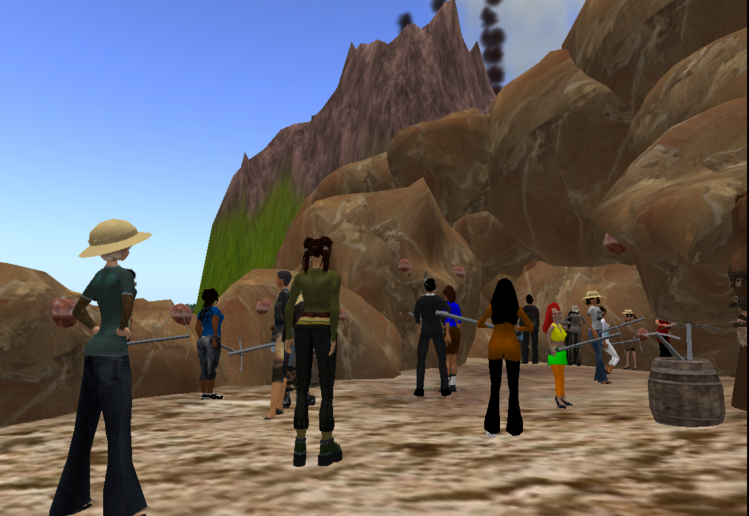If there’s one thing I’ve learned as an educator, it’s that you can only be a jerky foreman to your youth miners for so long before they fight back.
But I’m getting ahead of myself in the story…
Back in 2009, I was in one of the principal educators running “I Dig Zambia.” “I Dig Zambia” was a two-week intensive summer camp that brought together a dozen teens in New York with another dozen in Chicago to learn about evolution, biology, paleontology, and social and cultural issues in Zambia. The camp took place within the virtual world of Teen Second Life, with the New York teens logging in from Global Kids headquarters and the Chicago teens participating from the Field Museum of Chicago.
One of the coolest things about organizing a virtual summer camp is that your imagination can run wild as an educator. I could literally tell my developer team to create almost anything — a spaceship, a castle, a zoo — and they would get to work on making it.
One of our goals with this camp was to give our teens a sense of the realities of living in Zambia. We decided to focus on the mining industry, which is a major part of the economy of Zambia. So I had my developers create a mine.
Imagine 20 teens all logged into the same virtual world, navigating their avatars to a cave in the side of a mountain. Nearby, a set of picks was laid out near the entrance that the teens could equip their avatars with. Heading into the mine, the teens quickly figured out that they could click on the walls to dislodge rock, extract ore, and make a small amount of money (a few pennies every dozen or so pick strikes.) Teens started boasting about how much money they had made. “Hey, I made 50 cents!” “I’m close to a dollar!”
Then, randomly, bad things started happening. One teen broke her pick, and had to pay for a new one that cost 75 cents. “But that’s all my money!” she complained. Another one injured his hand and had to wait a minute before he could continue mining. The more that they mined, the worse their luck got: more injuries, illnesses, and accidents.
They started strategizing about how to make the most money while avoiding injury. Some theorized that if they didn’t constantly mine and took little breaks, they would last longer. Some thought that areas of the mine were more hazardous than others and avoided that section.
After a couple of rounds of this, I announced as their “foreman” that I was going to be making some changes. I decided to take away everyone’s picks and charged them 25 cents to keep working. If anyone sassed me, they didn’t get a pick at all and were “fired.”
Pretty soon we had a very different situation. Some kids had injured or sick avatars who couldn’t work until they had healed up. Some were too poor to afford to buy a pick to continue working. And others were continuing to work, while their health was still okay. The game became a lot less fun.
Originally I was going to end the game when enough kids got incapacitated and have them talk about what they had learned about what life might be like as a Zambian miner. Then we would watch a video and move on to the next thing.
Instead something else happened. They organized.
One of our teens in New York named Amana decided that she didn’t like the way we had set up this game. Her avatar had been injured early, and then fired by me for complaining when I wouldn’t hired her back.
Amana started typing into the group chat to the whole group, “Hey, everybody, this is totally unfair! We can’t work under these conditions!”
Other teens agreed with her in the chat.
Amana went into the mine and told the remaining miners to stop working. “Hey guys, this isn’t right. We need to strike for our rights!”
A couple of the other teens paused in their mining. And then a few more. Pretty soon, nobody was mining anymore.
“Strike for our rights! Strike for our rights!” the teens started typing in the group chat. They marched their avatars back and forth in front of the mine. If they had the skills, they probably would have fashioned some picket signs, or maybe a barricade.
The other educators on my team didn’t really know what to make of all this. This wasn’t in the lesson plan.
“OK OK,” I typed carefully in the chat. “The management has heard you. From here on forward, no one will be charged for their picks. And anyone sick or injured can have their job back when they get better.”
I gave everyone picks and there was a lot of jumping up and down and cheering. No one went back to work.
That activity was maybe 30-40 minutes long. But in that short a time we learned together so much about economics, corruption, and social justice. We got a tiny window into the lives of people half a world away. And the teens subverted the paradigm and challenged the “rules” to fight for what was fair.
And we still had the whole day ahead of us to learn more.
